Module 9-13 (terms are not really in order…)
1/144
There's no tags or description
Looks like no tags are added yet.
Name | Mastery | Learn | Test | Matching | Spaced |
|---|
No study sessions yet.
145 Terms
Single-case Designs
Can take two forms
Case study
Single-case experiment
Case study
An in-depth investigation of a single case of interest
Involves simple observation rather than manipulation of a variable
Single-case experiment
A design in which single participants serve as their own control group to study the effects of a manipulation or treatment
A participant acting as their own control
We can also make comparisons of behavior in the same individual over time
Often used as a pilot study to verify methodology, reliability of data gathering, and direction of results before spending the time and money to do a full-scale study
Single-case experiment Advantages
Decrease in error variance (variability in scores that is not due to the independent variables)
Due to less error variance they increase the power to detect a true difference compared to studying multiple participants in an experimental design
Increases statistical power
Single-case experiment Disadvantage
Inability to generalize the results to others
Variation of the Single-Case Experiment
A group of participants who share a single attribute can be investigated using the same methods as we use to study a single participant
For example, the population of soldiers who have been diagnosed with PTSD
In these cases, the “group” is already formed because we are not randomly assigning the participants to a group
Could measure the severity of their symptoms before and after a treatment
This is not a quasi-experiment, because we still have only one group
If we began comparing them to soldiers without PTSD, then we would have a quasi-experiment instead
Uses of Single-case Designs
When measures need to be added or refined
Used to assess behavioral interventions for children with behavioral disorders
The children come into the study with a specific diagnosed condition, and they cannot be randomly assigned to disorders
A special type of this design is used in functional behavioral assessment (FBA)
Functional Behavioral Assessment (FBA)
Used to assess problem behaviors in school children
Often in response to government policies
Usually conducted prior to attempting an intervention
As the goal of this is to identify environmental stimuli that might trigger or maintain a problem behavior
This information can then guide the development of an intervention that lessens or avoids the problem triggers and reinforcers
Can be conducted in either non-experimental ways (observation) or in experimental ways by
manipulating environmental variables, such as noise, suspected of being related to problem behavior
Is usually conducted with a particular student instead of a number of students
Types of Single-case Designs
Reversal Designs
Multiple Baseline Designs (Case Series Design)
Reversal Designs (ABAB design)
Periods of treatment and no treatment are alternated
We take an initial baseline of a targeted behavior
Use a treatment to improve the behavior
Reverse or remove the treatment to allow the behavior to go back to the original level of the targeted behavior
Then reinstate the treatment
Researchers expect to see that behavioral improvement will follow treatment, and once treatment is withdrawn, the behavior will go back to the baseline or pre-treatment level
It is necessary to resume the treatment since we previously found it to be helpful so we end the study with improvement in behavior for ethical reasons

Reversal Designs (ABAB design) Advantages
Have the opportunity to use systematic observation of behavior as it occurs in everyday life
Can see the alterations of behavior at each measurement point
And we can document any minor variabilities
Can monitor not only the extent to which the behavior changes,
But also the time it takes for the behavior to change during the course of the treatment
Is brief in terms of initiation of treatment and completion of data analysis
We have our baseline measurement, and we can easily and quickly measure the behavior on a daily or other regular basis
The ability to use each participant as their own control and observe the replication of any treatment effects within the two treatment portions of the study are additional benefits
Even when subtle changes in behavior are observed, we can then see whether we should use this same treatment approach for evaluation in a larger scale study
Reversal Designs (ABAB design) Disadvantages
There is no control condition to determine whether a simple observation of behavior is altering the behavior
Often have carry-over effects of the original treatment
so the behavior does not go back to baseline, but remains at post-treatment levels because the participant is not unlearning the newly learned skills
Ethical concerns related to withholding a known beneficial treatment, even briefly
Once we know that a treatment is successful in changing a “bad” behavior into a “good one,” it may not be ethical to remove the treatment and wait for the condition being treated to re-emerge
Reversal Designs (ABAB design) Pros & Cons
Pros:
Observe everyday behavior
Brief process
Clear process for data collection and analysis
Participants serve as own control
Replicate treatment effects within a single study
Cons:
No control condition
Possible carry-over effects
Ethical concerns about reversing treatment
Multiple Baseline Designs (Case Series Design)
A research design in which multiple people are studied with treatment beginning at different times
The method allows for the determination of the impact of the timing of treatment
This design controls for the fact that an individual’s behavior may change over time just because we start to pay more careful attention to it
We are again observing behavioral change over time in individuals
However, this time, we stagger the time at which the intervention takes place for each of several participants
Multiple Baseline Designs (Case Series Design) Process and example
The baseline testing and observation of the behavior would begin at the same time with each of the three participants, labeled A, B, and C.
Baseline behavior would be systematically documented for a period of time.
During baseline, the measurement of the behavior in question could be monitored every day for
Five days in Participant A
Ten days in Participant B
Fifteen days in Participant C
Participant A would begin the treatment phase of the study at day six.
The other participants would still be in the baseline pre-treatment stage.
After more baseline observations, participant B would then be exposed to the treatment followed by participant C.
The initiation of treatment after baseline documentation would continue until all participants in the study were exposed to the treatment.
Because we are watching each participant for different amounts of time, we should be able to compare the participants and see if the amount of time being watched influences their outcomes.
As with the reversal design, the treatment would be withdrawn from all participants after being administered for the same amount of time.
The expectation would be that for each participant, the behavior of interest would not change until the intervention began and the behavior would go back to baseline after treatment withdrawal.
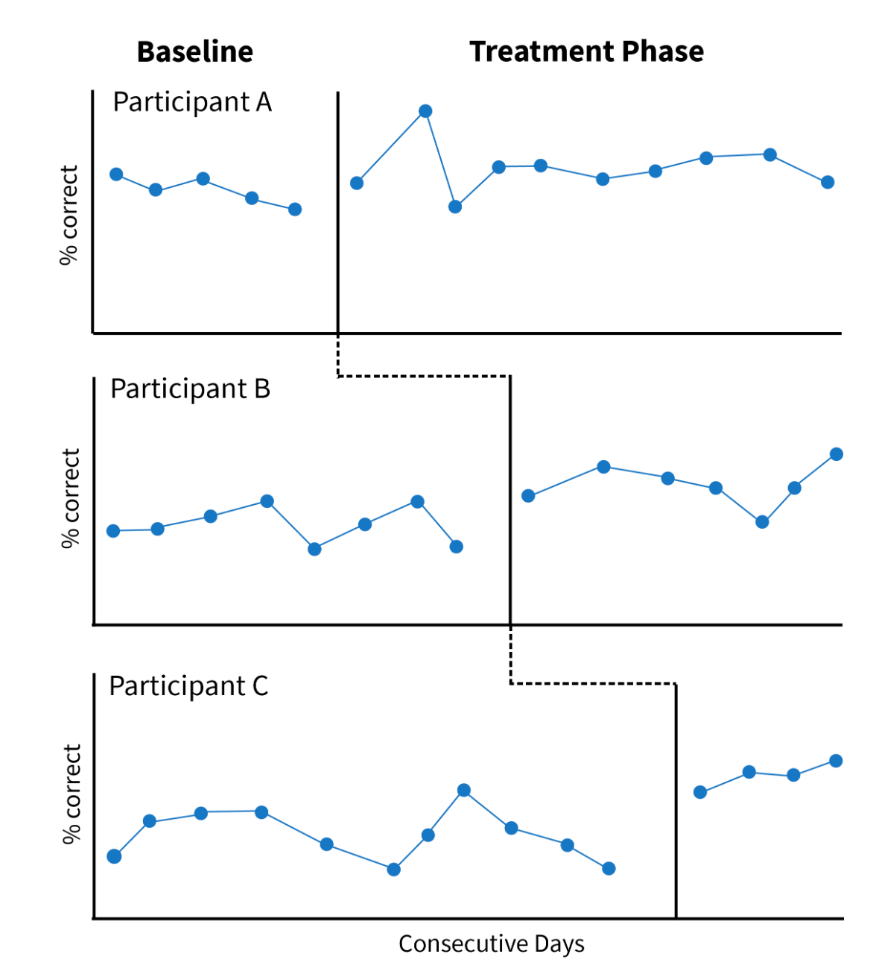
The Cohort quasi-experimental Design
The key feature of this design is that none of the participants have a feature or experience of interest at the beginning of our measures
Can take the form of birth era (the period of time to which anything is assigned, as in Millenials and Gen z) or any group that enters a “system” at a given point in time and is followed over time, such as grade school children, college freshman, nursing students, military enlistees, etc
For example, a birth cohort (e.g., Millenials) can be followed over time with multiple measurements to get an understanding of how responses to life events such as graduation from high school or birth of a first child might be different from other cohorts (e.g., Generation Z)
Two Types:
1. Prospective
2. Retrospective
Birth era
The period of time to which anything is assigned, as in Millenials and Gen z
Prospective Cohort Design
Cohort is identified first
The Framington Heart Study, begun in 1948, has followed initially healthy participants over time to see what factors contribute to the development of cardiovascular disease.
The study is now looking at its third generation of participants.
Might have to wait a long time before an outcome of interest occurs
Retrospective Cohort Design
Help us understand rare or unusual events
We could consider Gulf War veterans as our cohort and investigate the differences between veterans exposed to neurotoxins and those who were not to see the effects of neurotoxin exposure on health measures.
Have some challenges, might not know exactly who was and was not exposed and whether exposure differed among the participants
We don't know what other health habits, like smoking, might be present in our groups.
The Case-control Quasi-experimental Design
Behavior is observed first, then measurement of related variables is documented retrospectively
Researchers first take note of a behavior (such as adverse psychological responses to COVID-19)
Then they measure potential causes for the behavior, such as a pre-existing diagnosis of obsessive-compulsive disorder (OCD)
Time-Series Quasi-experimental Designs
Involves repeated measures over time
Common type of design in developmental psychology
Different from Repeated Measures in that we do not have random assignment to groups
This along with cross-sectional designs are often used to investigate the changes associated with aging
Interrupted Time-Series Design
The study of a variable over time, with the interruption being a treatment procedure
A one-group design in which the "interruption" is a treatment
The time-series refers to the periods before and after the treatment
This design features:
1. Several pre-tests taken over time,
2. An intervention,
3. Multiple post-tests taken over time

When is Interrupted Time-Series Design Useful?
This design has been used in place of a true experimental design when the manipulation of behavior is not feasible or not ethical.
Used when we need to evaluate changes in a population of interest
Example: The Centers for Disease Control and Prevention (CDC) reports that heart disease is the number one cause of death in adult women
Using this design, you could track the rate of heart disease among women in a community before and after a public health campaign providing information about how to prevent heart disease.
The campaign serves as the "interruption."
If heart disease rates decrease significantly after the campaign, you could argue that it was effective.
Multiple Time-Series Design
A type of time series design featuring the addition of a control group of participants who are not exposed to the treatment, but have the same number of measurements of the same variables.
Combines aspects of the non-equivalent control group design and the times series design
Extending the number of measures compared to the non-equivalent group design improves control of some of the threats to internal validity
These designs differ from the interrupted time-series in that there is now more than one group
Each group is evaluated on a dependent measure multiple times before and after an intervention
But one group does not have exposure to the intervention
The comparisons are made not only within the experimental group before and after the intervention
But also between the experimental and the control groups

Program Evaluation (What is program evaluation?: A Brief Introduction on youtube)
Uses the methods of science to determine the effectiveness of a program
Has the inclusion of a value judgment in response to the data
Variables like the "success" of a program should be operationalized at the very beginning
Factors commonly assessed:
1. The need for the program or service
2. The design of the program or service
3. How the program implements its service delivery
4. The outcomes of the program or service
5. The efficiency of the program or service
Quantitative, qualitative, or mixed methods can be used
The design decision will depend on:
the type of the program,
the questions the researcher is trying to answer,
the data used to determine program success
Best Practices in Open Science: Do You Really Know How Your Groups Differ?
This means that although we think we know what our independent variable is, we really don't know for sure.
Careful researchers try to account for these types of confounding variables in their studies, and use specific statistical methods to rule them out as factors
However, there is always the possibility that factors we don't know about are still important to the relationships we're proposing.
We must be extremely cautious and humble regarding the reporting of our findings
Stating what we do and do not know about our variables and their relationships as completely and clearly as possible is not only honest,
But it also helps other researchers attempt to replicate and extend our findings
Multi-Method Analysis
Qualitative methods can be used alone or with Quantitative methods
Address Typical Power Differentials Between Researcher and Participants (Commonalities in Qualitative Methodology)
Researchers try to match the gender, race, ethnicity, first language, and socio-economic status between the participant and those who represent the “face” of the study (in-depth interviewers, focus group facilitators, etc.)
Real or perceived hierarchy provides a potential barrier between the researcher and the participants and perhaps increases the risk of social desirability bias
a kind of response bias wherein study participants maximize what they believe are "good" responses and minimize what they believe to be "bad" or undesirable responses
Address Diversity Holistically
It is noteworthy that methodologies which overtly acknowledge the potential for bias in the scientific method tend to be more qualitative in nature.
Qualitative Theories
Three approaches to Qualitative work:
Grounded Theory
Ethnography
Phenomenology
Grounded Theory Approach
Theory “emerges” from the data itself
A “constant comparative method” wherein new data is matched to existing data throughout the study to look for commonalities and emerging themes
Rather than citing a theoretical framework and hypothesis in advance of the research
This theory approaches the research with general ideas and/or topics of inquiry and collects research until data saturation is reached
Sampling and analysis are not distinct, but rather iterative and aimed to “go where the questions are”
Is often the framework of choice for exploratory questions where there is a significant gap between theory and empirical understanding of the topic
Seeks to show the depth of the phenomena under study
Seeks to define and differentiate themes from each other
Ethnography
Research questions determined by in-depth field work
Systematically studies patterns between people and cultures
Often bridges the gap between the fields of psychology, sociology, and anthropology
Is relational and contextual
It delves deeply into the values, shared understandings, and relationships within a community
Can enlighten social change by providing a platform for marginalized voices and encouraging social action
Usually involves immersion into the setting
Is relatively unstructured as compared to grounded theory
Heavily relies on participant observation
Is typically inductive
Highly relational and iterative
Provides an opportunity to study a cultural topic in depth
Phenomenology
Relationship between people and objects mutually influence each other to create theory
Rooted in philosophy
Reject data and themes altogether and prefer to collect capta
Collection of consciousness and objects that influence each other
Most often used early in the research process, with other approaches, and as part of the “discovery” phase of research
Seeks to holistically understand phenomena and remains flexible to meet this lofty goal
Maximizes the point of view of the researcher
The understandings of the participant are assumed to be real and valid, and they are analyzed with less interpretation, not more
Can be an excellent choice for social justice work
Capta
Collection of consciousness and objects that influence each other
Limitations of Qualitative Research
The widespread erroneous assumption that these methods are less rigorous
That the research quality is dependent on the skills of the researcher and easily biased by the researcher’s own perspective
That they are less well understood and that their rigor is more difficult to assess
This is avoided by honest and authentic attempts at making data collection and analysis transparent by publishing the codebook
That it is particularly susceptible to social desirability bias
Wherein study participants maximize what they believe are “good” responses and minimize what they believe to be "bad," or undesirable, responses
The high potential for confirmation bias
The researcher is more likely to find/analyze the data in ways that support their hypothesis rather than contradict it
Ex-post-facto
A research study that measures behaviour after the event in question, also known as “after-the-fact”
For example,
when evaluating a new vaccine, we would typically exclude pregnant women from participating in the study because of the potential for damaging the fetus. However, if a woman had already taken the vaccine prior to finding out that she was pregnant, she is now in an ex-post-facto group that we can study ethically
Triangulation
Using more than one method of data collection to provide validity to the research findings.
Dualistic thinking
a way of thinking that is conceptually divided into two opposing thoughts or categories
Correlational Research
Both a statistical technique and a research method
Research designed to determine whether an association exists between two variables
Can only indicate that two variables are related
“associated,” “related,”
Positive Correlation
As A increases, B increases
Negative correlation
As A increases, B decreases
Zero correlation
There is no relationship between A & B
Independent groups design
Also known as a between subjects design
Participants are non-overlapping between groups
You’re either in the treatment group OR in control group
Not in both groups, just one
Simplest form of this only has 2 groups
Random-Groups design (random assignment)
Each participant in the sample has an equal chance of being assigned to each of the groups
Allows researchers to establish causality
Only assigned to one of the groups (non-overlapping/independent)
Equates groups on potential confounding (or extraneous) variables
It is imperative that researchers ensure that their conditions are equivalent
Experimental Condition
Intervention or treatment
Give them drug pill
The thing you think causes your effect
Control/Baseline Condition (Business-as-usual)
Absence of treatment
Give them placebo pill
Without the thing you think is the cause
Formal Experimental Designs
Only difference between groups is what is the variable we hypothesize to be the cause (X) of some outcome (Y)
Why X might have caused Y
Can establish causality
Independent Variables (IV)
Manipulate
Levels of this are the Experimental and Control conditions
The presence or absence of what you’re testing (ex. drug and placebo)
Only thing determining the difference between the 2 groups is the experimenter nothing else
What we think is the cause
Should be the only thing that differs systematically between your 2 or more groups
Dependent Variables (DV)
What we Measure
Outcome
Can be categorical or quantitative
What we think is the effect
How Many Participants Do You Need in Your Study? (Independent groups design)
Depends on the effect size and desired power
Effect size
How much effect does our independent variable actually have on our dependent variable
How big of an effect you are expecting to find
If that effect exists, how sure or likely you want to be define that
If the group difference is very big and obvious, we don't need as many people to be able to detect it
As when the group difference is small.
Power
The probability of detecting an effect if it actually exists
The chance of detecting an effect that is there
A researcher's ability to find an effect size of interest if it actually exists
Need to collect data from enough participants to detect an effect if indeed an effect is present
Usually in terms of percent
If effect size is believed to be small you want more people
If effect size is believed to be big, you don’t need as many people
Representative samples
Have characteristics representative of the broader population
Important to make sure results generalize to other related groups of individuals
Confounding Variables
A ‘third variable’ that may differ between groups
Problematic if they systematically covary with the IV and DV
Decrease internal validity(the ability to make causal claims)
Confounding Variables: Examples
Differences in the environment (ex. room temp)
Differences in the individuals (e.g., differential motivation for mathematics)
Differences in the researcher (e.g., researcher cues)
1.Single-blind, 2.Double-blind
Participants don’t know what condition/group they’re in(they should never know)
Participants and Researcher both don’t know what condition/group participant is in (This one is considered Gold Standard)
can reduce expectancy effects
Matched Groups (9.6)
Groups are matched on some variable of importance (e.g., age, gender)
Ensure groups are equal to make causal claims
Increases internal validity
Internal Validity
Deals with experimental control
Extent to which we can be sure the IV is the cause of the DV
External Validity
Deals with generalizability
Extent to which we can be sure we can generalize our results to different populations
Threats to Internal Validity
Confounds
Experiments
The Golden Rules for Experiments
Random assignment to condition
Every member of a group should have an equal probability of being assigned to any group
Make everything identical between conditions other than the variable(s) you are intentionally manipulating
Repeated Measures Design
Participants serve as their own controls
Participants experience all levels of the independent variable (IV)
Measure the dependent variable more than once (at each level of the IV)
Also called within-subjects design
Because you’re comparing within a person
Example of a Repeated Measures Design
Independent variable: Text size
Levels: small text (5 point font) and large text (16 point font)
Dependent variable: Reading speed
Read a passage with small font and measure reading speed
Read a passage with large font and measure reading speed
Advantages of Repeated Measures Designs
Fewer participants needed
More power to detect significant results
Can measure change over time
Such as how seasons affect people’s mood
Disadvantages of Repeated Measures Designs
Unique situations than can only be experienced once
Order effects can decrease internal validity
Types of order effects
Practice effects
Fatigue effects
Carryover effects
Sensitization effects
Practice Effects
When performance is better in subsequent levels of the independent variable due to experiences in previous levels
Could happen in a study evaluating whether learning to play an instrument from an instructor or watching recordings is more effective
Fatigue Effects
Performance decreases on subsequent levels of the IV
Participants may get tired or bored since they are repeatedly experiencing the same/similar tasks
Example of Practice Effect
In a study on reading speed, participants read short passages in small font (5 point) or large font (16 point). They read 10 passages in the small size font then the same 10 passages in the large font.
Faster reading speed during the large font size reading could be example of this
Example of Fatigue Effect
In a study on reading speed, participants read short passages in small font (5 point) or large font (16 point). They read 10 passages in the small size font then the same 10 passages in the large font.
Slower reading speed during the large font size could be example of this
Carryover Effects
Effect of one level of the IV spills over into the next level
Carryover Effects Examples
Experiencing one dosage level of a medication could have lasting effects on the mood that carry over into the next dosage
Experiencing a hot room could have lasting effects on mood that carry over to evaluation in a cold room
Coffee will taste different before you eat cake compared to after you eat cake
Sensitization Effects
Participants act differently on the next level of the IV after exposure to one or more other levels of the IV
Specific type of carryover effect in which an experience in one condition makes participants extra sensitive to the manipulated variable in the next condition
Sensitization Effects Example
Studying the effect of room lighting on reading speed
After reading in a dark room, reading in a bright room could be harder as eyes adjust
Counterbalancing
Balance order effects across different conditions to which participants are exposed
This is done to control order effects
Two types of this
Within-subjects
Across-subjects
Within-Subjects Counterbalancing
All participants experience all possible orders
All participants go through each level of the independent variable, just in a different order
Two types of this:
Reverse Counterbalancing
Block Randomization
Across-Subjects (Between-Subjects) Counterbalancing
Participants only experience one of the orders
There are two conditions A and B
Have half of the participants experience A then B
Have other half of participants experience B then A
Two types of this:
Complete Counterbalancing
Partial counterbalancing
Each condition should appear in each ordinal position (first, second, third, etc.) equally often
Each treatment should also precede and be followed by every other condition an equal number of time
Reverse Counterbalancing
Type of Within-Subject Counterbalancing
2-3 conditions: Each person experiences all conditions in one order, and then in a reversed order

Block randomization
Type of Within-Subject Counterbalancing
4+ condition: Each person experiences all possible orders of the conditions, in random sequence

Complete Counterbalancing
Type of Across-Subject Counterbalancing
2-3 Conditions: All orders are used, each participant only experiences one order
Partial counterbalancing
Type of Across-Subject Counterbalancing
4+ Conditions: in which a subset of possible orders are presented and each participant experiences one subset
Other Ways to Control for Order Effects
Different materials and stimuli
Washout Period:
A brief interval between levels of the independent variable to prevent order effects
Washout Period
A brief interval between levels of the independent variable to prevent order effects
Matched Groups Design
Researchers often use this method if they have a limited number of participants, and there is great variability among participants in a variable that is relevant to the dependent variable
Get pairs of participants who are really similar in a lot of ways (ideally identical twins) and get them to experience the 2 different levels of the IV
Pairs of participants experience the different levels of the independent variable—just as in a between-subjects design
Participants are matched on a variable relevant to the dependent variable
Advantages of between- and within-subjects designs
Basic Experimental Designs
One independent and one dependent variable
Complex Experimental Designs
Multiple variables
Factorial designs: multiple independent variables
Multivariate designs: multiple dependent variables
Factorial Designs
Multiple independent variables
When it’s this design, tells you that the predictors are categorical
In a study you have a drug X drug Y and a placebo
Those are categories
The reason we would have a study
with multiple predictors is almost always because we think that, the effect of one of the predictors on the outcome might depend on what's happening with the other predictor
Has main and interaction effects
Multivariate Designs
Multiple dependent variables
2 x 2 Between-subjects Factorial Design
Two independent variables in the same study
Different participants in the various conditions
4 groups
(# x #) # refer to the number of levels in each factor
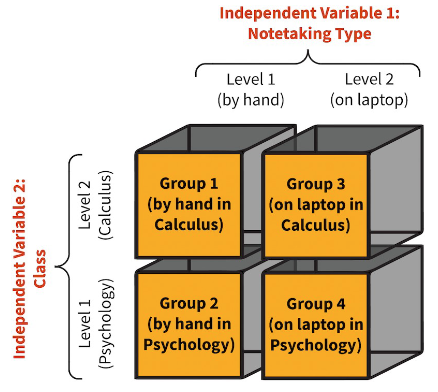
Example of a Factorial Design
How does playing video games influence cognitive functioning?
IV#1: Game type (Adventure vs. RPG)
IV#2: Time played (3 hrs vs. 6 hrs)
Confirmatory hypotheses:
The researcher specifies what effects they expect to find
Exploratory hypotheses:
The researcher does not specify what results will be found
You think there's something about the effect of one of them might differ, depending on the other one
Confirmatory/Directional Hypotheses
The researcher specifies what effects they expect to find
You have a very specific effect that you think you’re gonna find
Exploratory Hypotheses
The researcher does not specify what results will be found
I think, there might be interaction between these 2 predictors, But I'm not sure what it's gonna be
An Example of a Factorial Design: Contingency Table
Factorial designs have main effects and interaction effects
This shows cell means and marginal means
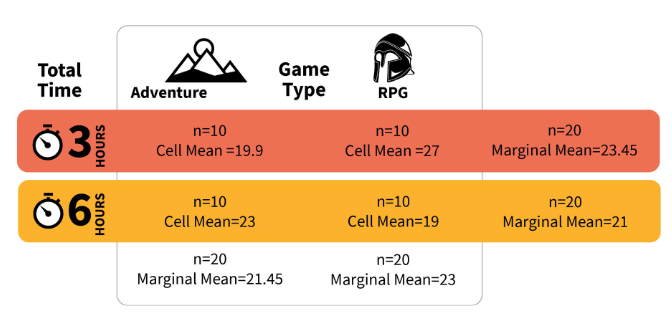
Main Effects in Factorial Designs
Compare all differences between levels of one independent variable across levels of the other
When we just isolate the effect of one of the predictors
Just comparing the rpg game vs the adventure game (ignoring time spent playing)
Or just comparing playing for 3hrs vs playing for 6hrs (ignoring the type of game that was played)
The differences in mean scores between the levels of each independent variable across the values of the other independent variable (i.e., the marginal means)
We state that there are two main effects, a main effect for “game type” and a main effect for “total time”
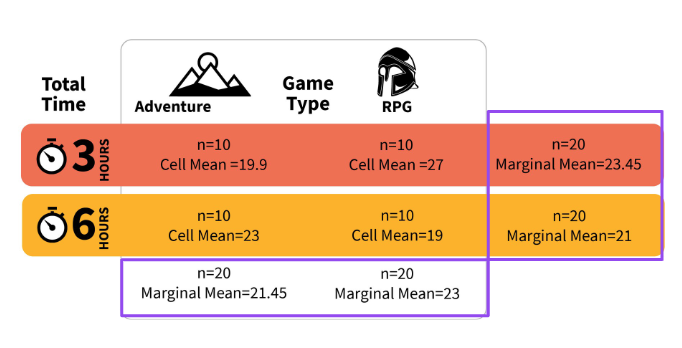
Interaction Effects in Factorial Designs
Describing main effects in reference to each other
Combined Effects of independent variables
An effect of one IV on the DV depending on the level of the other IV
Every participant in each cell is exposed to one level of both independent variables. For example, the ten participants in each cell are exposed to one level of the game type variable and one level of the total time variable. You could say that both independent variables come together in that cell. Researchers refer to this as an interaction. The meaning of the prefix “inter” is between or among, so we can say there is an “inter”action between the two variables that takes place in that particular cell. It’s as if you could not describe one variable without the other
Example: Ice Cream Preference
Ice cream you prefer on its own
= Main Effect
Preference for what ice cream you want, depending on what you're having (with Pie)
________ ________
Other Variations of Factorial Designs (Specifically 2×3)
More than two levels for the independent variable
A main effect does not clarify which levels differ
Post-hoc tests:
Allow researchers to compare the means of the levels of the IV
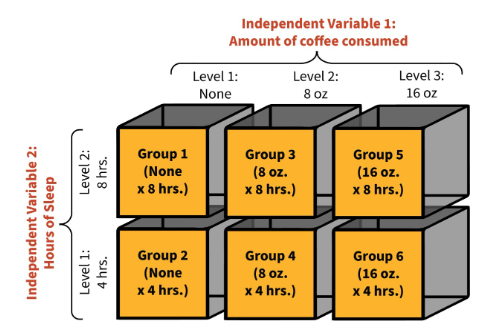
Post-Hoc Tests
Allow researchers to compare the means of the levels of the IV
Higher-Order Factorial Designs
Have additional main effects and interactions
A design with three or more independent variables (2×2×2)
2 (three hours versus six hours)
x 2 (adventure versus RPG)
x 2 (low versus high delay of gratification) design has six conditions
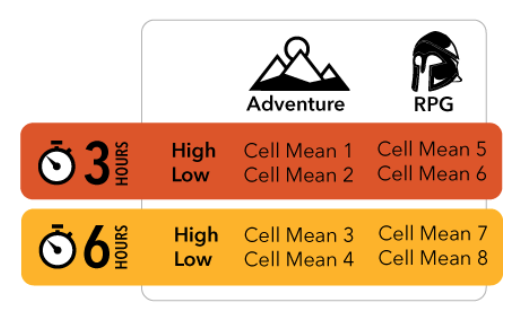
Repeated Measures Complex Designs
Participants are exposed to all levels of the independent variable
Increased statistical power
Be wary of order effects, interference effects, fatigue, and other confounds
The same group of participants take part in all of the conditions
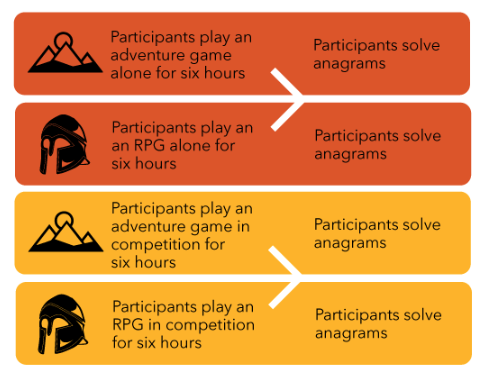
Mixed Designs
Includes between-subjects and repeated-measures design features
Example:
We randomly assign participants to study in either a re-reading or retrieval practice condition and have all participants take a test in a hot and cold room.
This is a 2 (Between factor: re-reading or retrieval practice study method) x 2 (Within factor: hot and cold room temperature) between-within mixed design